ADD, ADHD, Hyperactivity
Parents want the best for their children. Having to watch them struggle academically, socially and behaviorally can be emotionally painful. Once your child has been identified as having a problem and a formal diagnosis or label is given, the question becomes what to do treatment wise. For parents of an ADHD child the only solution typically given is stimulant medication. Most parents innately know that the medications are not getting at the root cause of the problem, but unfortunately, in almost every case they are not given another approach. When it comes to doing the best for your child, it is important to fully understand all of your treatment options.
The following will give you some insight and hope that a better solution is available. Here is how we are different:
We Address the Underlying Neurologic Problem

In helping a child or teenager with a neuro-developmental disorder such as ADHD it is essential to address the underlying cause of the disorder. As Functional Neurologists we know that a properly functioning brain requires communication between both hemispheres. This communication via nerve impulse within the brain should occur very fast. In children with neuro-developmental disorders this communication is slow or out of sync. This miscommunication between the two sides of the brain is called Functional Disconnection Syndrome and is the root cause of many childhood neurodevelopmental disorders.
When the brain is out of sync and there is poor communication between the two hemisphere there will be learning, behavioral and social problems.
It is unfortunate, but typically, when a child is evaluated due to a learning, behavioral or social disorder, they undergo minimal neurological examination and are usually given a label as having a disorder such as ADHD, a learning disability or autism. The majority of these concerns such as ADHD, learning disabilities, reading disorders, OCD, Autism, Tourette’s Syndrome, Asperger’s Syndrome and sensory processing disorders are caused by Functional Disconnection Syndrome.
These conditions can be caused by either a left brain deficit or a right brain deficit. For example children or teenagers struggling with ADHD and poor focus typically have a Functional Disconnection Syndrome affecting their right brain. The majority of the Autism Spectrum disorders such as ADHD, Asperger’s Syndrome, PDD-NOS and even OCD are right brain deficit problems. ADHD is a less severely involved right brain disorder as compared to autism. In ADHD, many times just one region such as the right dorsolateral pre frontal cortex is involved, where in autism, many regions of the right brain may be involved.
Problems such as dyslexia, reading disorders, learning disabilities and poor handwriting are typically caused by left brain deficits.
In order to fully understand these neurodevelopmental disorders, Its essential to look at them in terms of “hemispheres,” or sides, of the brain.
When we understand what each side normally does for a child when they are in balance (integrated), we can understand what goes wrong when there is an imbalance (functional disconnection).
The Right Hemisphere:
- The “brake” pedal
- Withdrawal responses: stop movement, stop thought
- Controls gross motor: posture, big movements
- Likes Low Frequency Stimulation
- The “Where” part of the brain
- Non-linear, “creative”
- Non-verbal communication: face, eyes, body
- Stimulated by novel, new stimuli
- Reading and math comprehension
- The “sad” brain
The Left Hemisphere:
- The “gas” pedal
- Approach responses: initiates movement, initiates thought
- Controls fine motor: small movements
- Likes High Frequency Stimulation
- The “What” part of the brain
- Memorization of facts
- Verbal fluency
- Likes routines, sameness
- The “happy” brain.
Here are a few signs a Brain is Out of Balance
- Loves TV, Videos, computer
- Like sameness, routines, rituals
- Often great memory
- Normal and often above average intelligence
- Poor social skills/poor verbal skills
- Tantrums, poor emotional control
- Very self-directed, not very passive
- Tendency to fidget or stay moving
- Tend to fixate (perseverate)
- Often have “sensory” issues
- Reading and learning issues
- Language delays
One may ask why are there language delays in Autism if it affects the non- dominant non- verbal right hemisphere?
The Right hemisphere is responsible for non-verbal communication whereas the left hemisphere is responsible for verbal communication.
Non-verbal communication is the foundation of verbal communication. One must first have non-verbal communication such as understanding one’s feelings,facial expressions and body language before verbal communication develops. Essentially the non-verbal precedes the verbal.
If a child has a right brain delay, they never develop these and the functional disconnection inhibits communication of the right non- verbal with the left verbal.
Without these basic pillars of communication, appropriate verbal communication is delayed.
One method to encourage appropriate speaking in these children is to work on building the foundation—non-verbal communication which is the right brain.
Why are there so many “sensory” problems with these children?
Sensory issues most often are not a problem with the particular “sense.”
Often the problem is with the frontal lobes and inappropriate withdrawal responses to the sensations.
We Look At Overall Brain Function
We look at each specific brain region that could be affected. In addition, we also examine the child or teenager’s specific functional capabilities and the neurochemical components as well. This is different from just using parental questionnaires and generalized batteries of tests, and quick observation to make a diagnosis or assign a label. That approach does not look at various areas from a functional neurological model.
The traditional treatment option of medications do not take into consideration the issue of HEMISPHERIC IMBALANCE and which side of the brain needs more stimulation? Right or left? They also do not look at the specific areas of that side such as the parietal lobe, the temporal lobe, the frontal lobe or the cerebellum.
We are also very concerned about knowing the individual child’s brain metabolic capacity or endurance.
How much therapy can they handle? What is too much? What is their neurologic stamina? We don’t want to over stimulate or exceed the child’s metabolic capacity with our therapies. This approach is very individualized . We determine all of this in our examination.
We Do Not Treat With Medications
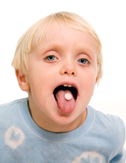
Medications affect the brain globally as a whole and are not specific or able to bias certain neurological areas. It is not possible for a chemical to only affect the specific areas of the brain injured by the concussion and not the non-injured areas. For example, if only the left side of a person’s brain stem is affected causing dizziness and poor balance, how could the chemical action of the medication only affect one side and not the other? It is for that reason we do not use medication and instead use specific brain stimulations to train and repair the specific areas affected by the concussion.
The most current research is supporting this approach.
A conventional medical neurologist is typically focused on the diagnosis of structural pathology and utilizes only pharmaceutical and surgical interventions to treat disease.
A Functional Neurologist views the nervous system as a moldable, changeable entity that can be affected in its function through virtually unlimited types of environmental stimulation and specific therapies. This concept of the brain being able to change its function throughout life via environmental stimulation is termed neuroplasticity and is at the very core of a Functional Neurologist’s clinical methodology.
Medications do work at suppressing the symptoms, but they are not addressing the root cause and can cause unwanted side effects.
Studies show central stimulants can be responsible for the following:
- Decreased growth
- Decreased brain growth
- Increased aggression and anti-social behavior
Use of central stimulants for more than 1 year was: “significantly and pervasively implicated in the uptake of regular smoking, in daily smoking in adulthood, in cocaine dependence, and in lifetime use of cocaine and stimulants.”
According to the FDA and the National Institute of Health Ritalin is associated with a 500% increase of sudden cardiac death.
We use a Bottom Up Neurological Treatment Strategy
Proper sensory and motor development is essential for proper growth and development of your child’s brain. Your child’s interaction and experience with the world provides the sensory and motor stimulation required to build and develop their brain.
To understand how our therapies work it is essential to understand how the brain develops through The Brain Development Pyramid:
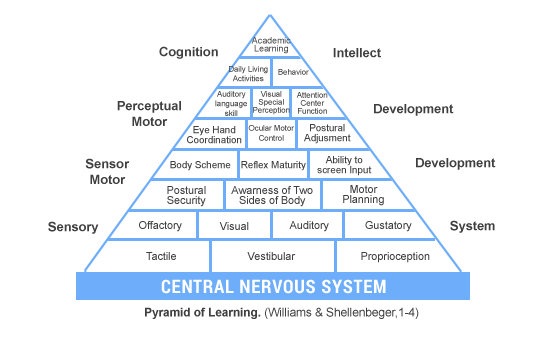
The brain develops from the bottom up — from the brain stem up to the cognitive cortical centers of the brain. When a baby is born, their brain stem is the primary area of their brain that is developed and functioning. The higher level cortex has not yet developed. The brain stem controls all internal organ functions and causes movements that are primitive and purely on reflex such as hand grasping, sucking and rooting.
With proper neurologic development these primitive reflexes governed by brain stem activity should be remediated or inhibited and hidden. Sensory stimulation such as hearing, vision, touch, taste, smell and inner ear or vestibular begin to develop the sensory areas of the brain. The sensory stimulation provides feedback to the lobes of the back of the brain to drive and build them.
The next developmental milestone is motor and frontal brain development where movement of the legs and arms, pushing up on the belly, eye tracking to follow objects, voluntarily grasping objects, rolling over, pulling up, crawling and walking occur.
The motor system drives the sensory stimulation leading to the next stage of development: sensory motor is when body awareness, reaching for particular objects, postural security, and motor planning develop.
Next is perceptual motor where language skills, spatial awareness, eye hand coordination and ocular motor control develop.
The last stage of development is cognition when attention/focus, behavior, social skills and academic learning occur.
These stages are the basis for developmental milestones that we use to determine how our children are growing. Delays at any level can cause altered development of the following stages leading to issues in attention, behavior, academic learning and social skills.
With the traditional care of tutoring, counseling and medication, ADHD, Autism and learning disabilities are evaluated and treated at the top of the pyramid in an attempt to address the cognition, social skills and attention and focus directly.
The problem is that ,without developing a strong base, it is virtually impossible to correct these problems from the top.
If there is a problem in the bottom or middle stages (such as an infantile reflex that is still persistent, a sensory development issue, an issue with proper cross crawl mechanism, improper oculomotor control, poor eye tracking or other aspect of the early development), then the later components such as attention/focus, language skills, behavior, social skills or academic learning will suffer and not function properly.
This hierarchy of development supports a bottom-up strategy including sensory motor therapies to go back and work areas that may not have been fully developed.
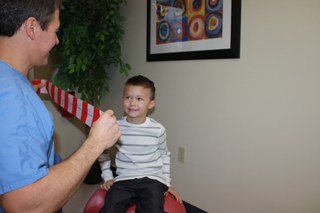
Before any higher learning, behavioral, attentional, social or academic improvements can take place, there must be improvement in motor skills and sensory processing.
Almost every child with a brain imbalance causing a neurodevelopmental disorder will also have issues with their motor skills making them clumsy, uncoordinated and awkward. In some cases this can be obviously seen in their gait, posture and gross movements. In other cases it is very subtle and only seen in the smoothness or accuracy of their eye movements. Other motor activities that can be affected are: vestibular (balance), posture, eye movements, primitive reflexes, fine and gross motor skills, handedness, muscle tone, rhythm and timing and strength.
Our program strengthens deficient motor skills and improves integration of sensory processing. To accomplish this we use the following specific motor exercises and sensory stimulations to produce neurological improvements in the children we work with:
- Eye exercises
- Gaze stability exercises
- Core stability exercises
- Rhythm training
- Interactive metronome
- Auditory stimulation
- Proprioceptive stimulation
- Balance training
- Fine motor
- Gross motor
- Primitive reflex retraining
- Strength training
- Muscle stretching
- Vestibular stimulation
- Improved attention and focus
- Eliminate or reduce the need for stimulant drugs
- Filter out internal and external distractions
- Filter out internal and external distractions
- Improve coordination and balance
- Improve fine and gross motor skills
- Have a better ability to regulate emotions
- Reduce anxiety
- Reduce hyperactivity and improve the ability to sit still
- Reduce unwanted motor movement such as tics and stimming
- Improve reading
- Better regulate emotions

We Combine the Latest Research-Backed Neurological Examinations and Advanced Neurological Testing
The advanced neurological testing procedures listed below allow us to pinpoint brain impairments that may be responsible for your child or teenager’s neuro-developmental concern. Most children 6 years old and over have no problem having these computerized oculomotor tests performed. In fact most think the goggles are pretty neat. Some younger children or those with more advanced autism or sensory issues may not have these tests or others performed. In those cases we rely on the bedside neurologic examination testing.
Video Nystagmography VNG
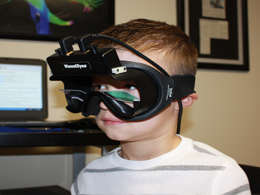
VNG is a computerized system used in the assessment of the oculomotor system (nervous system control of eye movement) and the function of those areas of your brain controlling these movements.
The VNG test is comfortably performed in our office. We simply place special goggles with an infrared camera on your child or teenager’s head to record and measure their eye movements in both light and dark conditions. Specific areas and pathways of your child’s brain are activated during different types of eye movements. During the test, computer software is recording and graphing their precise eye movements as they follow a visual target with their eyes. By measuring their recorded eye movements and displaying them on the computer screen, we can see how they compare to normal measurements.
The following eye movements are measured by VNG:
- Gaze Stability: It is essential that the brain stabilizes the gaze of the eyes for proper focus and attention as well as motor coordination. One of the most common ocular motor deficiencies seen in neuro-developmental cases is poor gaze stability. This can be seen on the VNG tracing.
- Pursuits: Pursuits are slow and steady eye movements that allow you to track a moving object. Good, smooth pursuits are essential to everyday functions but are particularly important in the mechanics of reading. When a patient reads the line of words in a book they are using their pursuit mechanism. The smoothness of the pursuit mechanism is commonly altered in neuro-developmental disorders.
- Saccades: Saccades are fast eye movement used to shift a person’s gaze from one object to another. Saccades are generated by the frontal lobes of the brain. The frontal lobes are important in executive functions such as attention. A child’s saccades can be evaluated to determine their level of frontal lobe development and function. Saccades need to be fast and accurate. Saccades are also used in reading when a person shifts their line of site from one line they are reading to the next. If the saccades are not accurate this can affect a child’s ability to read.
- Optokinetics (OPK): This is an essential eye movement that allows for visual function as the surrounding visual environment passes by. When these are dysfunctional it can indicate poor brain function. Rightward OPK is generated by the right brain and leftward OPK is generated by the left brain. The quality of the OPK response can help us determine what side of the brain is not functioning as well. This brain imbalance is seen in many neuro-developmental disorders
- Vestibular Ocular Reflex: When you child moves their head their eyes should move equally in the opposite direction if this reflex is functioning properly. This reflex is poorly developed in children with neuro-developmental disorders.
The VNG eye movement tracings provide invaluable neurologic information concerning specific areas of your child or teenager’s brain. We are experts at analysing these specific eye movements and determining if they have been developed properly and are functioning properly.
We correlate the VNG findings with our other testing and examination procedures to develop a specific therapeutic program for each individual child.
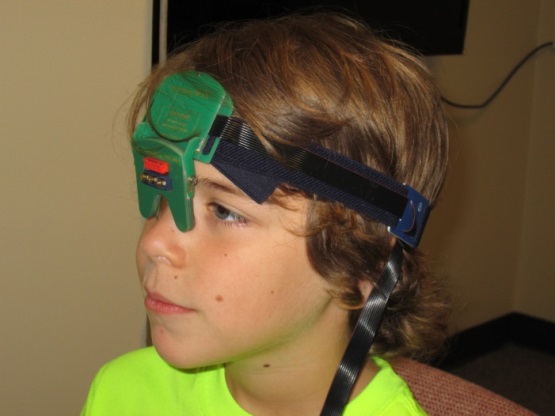
Saccadometry
We also measure your child’s saccades using saccadometry. As described above saccades are quick movements of your eyes that allow you to voluntarily move your eyes quickly from one object to another or to react by moving your eyes to a suddenly appearing target reflexively. Saccades can also be measured using a device called a saccadometer. The saccadometer measures different aspects of the saccades than the VNG measures. The saccadometer is strapped around your child’s head using an elastic headband. Within the unit, there is a laser that projects targets onto the wall that a patient will look at quickly or saccade to. The saccadometer will measure the eye movements at the same time.
Studies have shown saccadic testing to be a very accurate way to detect areas of improper brain development and function. This test cannot be altered voluntarily by the patient because you cannot consciously control the speed of your eye movement during each saccade; your eyes move as fast as they can. The purpose of your saccadic eye movement is to aim the part of your eye with the best vision (fovea) at the thing you want to see most, and then hold your eye there as you examine it.
Saccades are the only human physiological function that use every area of the brain. It is for this reason that we can evaluate a person’s saccades to determine what areas of the brain are not functioning at par.
Some of the brain areas used in controlling saccades involves three main brain regions: the frontal eye fields, the parietal eye fields, and the supplementary eye fields; and several subcortical areas in the basal ganglia, thalamus and brainstem. These areas are commonly not developed as well as they should be in children with neurodevelopmental disorders.
Saccadometry very precisely measures these aspects of saccades:
- Latency: This is the reaction time taken for the saccade to fire or activate after a new stimulus or target is presented. A normal reaction time should be less than 200ms.
- Velocity: The speed of a saccade is highly related to health of areas in the brain stem commonly affected in neurological disorders.
- Accuracy: The ability to make the eyes stop and land directly on the target they are saccading to or looking toward is essential to a person functioning in their environment accurately. If the saccade overshoots or undershoots the target it may indicate that the cerebellum or the area of the brain that makes the environmental grid may not be functioning so well.
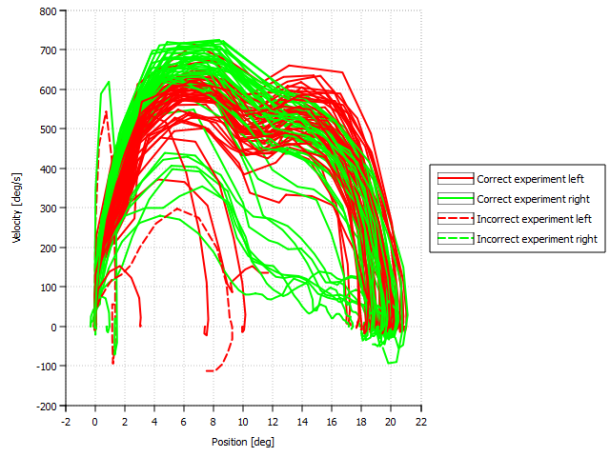
The saccadometer computerized graph shows leftward saccades that are generated by the right brain hemisphere as red and the rightward saccades that are generated by the left brain as green. This can be very useful in determining what side of the brain is out of sync.
Interactive Metronome (IM) diagnostic testing
We use interactive metronome long and short form diagnostic testing to assess a child’s focus, timing and ability to coordinate visual and auditory stimulation while doing a gross motor skill.
IM is an assessment and treatment tool used by therapists and other professionals who work with pediatric and adult patients with neurological conditions that affect cognitive and motor functioning. IM provides an objective method for measuring deficits and for tracking improvement.
IM is an evidence-based and engaging therapeutic modality that improves cognitive and motor skills. The design of the program ensures that patients recognize progress as it occurs, increasing their motivation toward therapy and their ultimate recovery.
- IM is used to improve:
- Attention
- Coordination
- Language processing
- Reading and math fluency
- Control of impulsivity/aggression

Children with brain imbalances tent to be poor eaters. This is because having a functional disconnection causes them to be particularly sensitive to the flavor and texture of food causing them to be fussy and finicky. They also tend to always want to eat the same foods over and over, and frequently, these are the foods to which they are highly sensitive. This can cause poor digestive health and nutritional deficiencies.
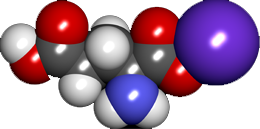
The brain controls the digestive system and the immune system. When the brain is out of balance, the digestive system and the immune system do not function well. A weak brain will create an underdeveloped and weakened digestive system. causing an opening of the tight junctions that divides the intestines from the blood stream. This is called intestinal permeability or leaky gut. A leaky gut allows undigested proteins to enter the bloodstream causing the immune system to become hyperactive and triggering bodily inflammation. This inflammation can cross over and inflame the brain too.
The process is mediated by cells called microglia. Once the microglial cells are activated, they tend to persist in this state and can actually create even greater neural inflammation over time
There are specific dietary recommendations and nutritional supplements that can improve a leaky gut and reduce this brain inflammation to support a better environment for the brain to function. We combine these evidence-based, drug-free dietary recommendations and nutritional supplements with our specific brain therapies to achieve maximal benefit for children and teenagers in our program. We will customize a simple step by step nutritional program that will be easy to fit into your child’s life.
We base a patient’s specific nutritional needs on preliminary lab results. The following are some of the lab tests we may run to determine the best nutritional approach each individual child will need.
Preliminary Lab Testing
The effects of a concussion can be compounded by the person’s metabolic health prior to the injury.
- A Complete Metabolic Panel (CMP)
- A Lipid and Thyroid Panel
- A CBC (Complete Blood Chemistry with Auto Differential)
- Vitamin and Mineral Testing (Vit D, B12, Calcium, phosphorus etc)
- Inflammation Testing: We test for Inflammation in your system by testing Homocysteine Levels and C – reactive protein (CRP).
- Iron and Ferritin Testing For Anemia
We can assess your child’s thyroid, adrenal, immune, blood and gut function. All can be affecting their brain health and function. By addressing any problems with their thyroid, adrenal glands, immune system, blood chemistry or gut function, we can help their nervous system to function more properly. The complete metabolic panel allows us to check their blood glucose levels since glucose and oxygen are needed by the brain to function properly.
Special Lab Panels and Testing
Your child’s preliminary blood testing will let us know if any of the special testing listed below will be necessary:
- Cyrex array 2-Intestinal permeability (Leaky gut testing)Many children have a microscopic breakdown of their intestinal wall known as intestinal permeability that may be a result of poor brain function or a poor diet. This breakdown, called leaky gut, will cause the small intestines and colon to become inflamed as well as allow the brain to maintain its inflamed state. An inflamed gut will cause an inflamed brain. Cyrex Labs specialized immune testing for intestinal permeability will determine if you have leaky gut and, if so, what specific type. There are 3 types of leaky gut, each have a specific treatment approach.The Gut-Brain Connection:The gastrointestinal system is known as the “Second Brain” and has just as many neurons as the brain itself. Our 2 brains- the one in our head and the one in our bowel- must cooperate. When they do not, then there is chaos in the gut and misery in the head-everything from “butterflies’ to cramps, from diarrhea to constipation.
Michael D. Gershon, MD author of “The Second Brain”Cyrex array 3- Advanced gluten sensitivity testingA large number of children with neurodevelopmental issues are also gluten sensitive and may have excess gut and brain inflammation from gluten sensitivity. This can compound and multiply the inflammatory cascade affecting brain inflammation.
- Cyrex array 4-Food sensitivity and cross reactive food testing: Children may also be sensitive to multiple foods beyond gluten. This test will pinpoint what foods are causing excess gut and brain inflammation. (See CYREX Gut Brain Immune video tab on website)
- Stool Microbial Ecology testingThis identifies intestinal bacteria, yeast, parasites and dysbiosis. Eliminating intestinal inflammation will help to reduce overall body and brain inflammation
- Adrenal Stress Index (ASI)We can further test your child’s adrenal glands. The adrenal glands are the “stress” organs, meaning that they react to stress by creating cortisol. If your child suffers with anxiety, tends to be more stressed or is taking stimulant drugs, their adrenal glands may be affected. When their body’s cortisol levels are abnormal, it is a sign that their body’s sympathetic nervous system is over-firing. Abnormal cortisol levels can be corrected via specific neurologic and nutritional protocols.
Specific Nutritional Protocols
These specific nutritional protocols are based on your child’s neurological testing, their blood work findings and their special lab panels. Our goal is to provide the brain with the best metabolic environment to support and obtain the best results from our neurological care. These protocols are designed specifically for your child and may include any of the following:
- Specific diet and supplement protocols for leaky gut correction.
- Specific diet and supplement protocols to decrease brain and gut inflammation.
- Nutritional protocols for abnormal adrenal (stress gland) function.
- Food sensitivity diet recommendations.
- Diet recommendations to reduce hyperactivity.
- Natural neurotransmitter support to improve focus and motivation, reduce anxiety and improve sleep.
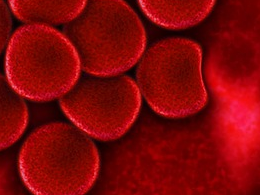
For information about our Reduced Cost Child Neurodevelopmental Recovery Evaluation including our neurological exam, advanced diagnostic testing and Report of Findings please put your name and email in the box below and we will send it to you right away! Thanks
For information about our ADD, ADHD Evaluation, Neurological Exam and Report of Findings plus details about our full length ADHD Video and Report, put in your information below and we will email it out right away. Only your name and email is required.
ADHD Research
1. Study: ADHD Linked to Asthma and Allergies
ADHD Linked to Asthma and AllergiesResults of a recent study published in the August 2013 issue of the Annals of Allergy, Asthma, and Immunology link ADHD symptoms in boys to higher instances of asthma, allergies, and skin infections. A Health Day article (1) detailing results of the study shared the following:”Boys diagnosed with attention-deficit/hyperactivity disorder are more likely also to have asthma, allergies and skin infections than youngsters without ADHD”, a new study finds, suggesting a possible link between these conditions. Of those in the study, boys newly diagnosed with ADHD were 40 percent more likely to have asthma, 50 percent more likely to have needed a prescription for allergy medicine and 50 percent more likely to have had a bacterial skin infection than other boys.’
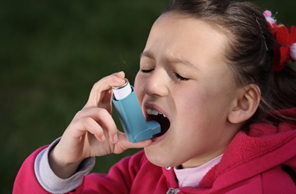
Our study provides additional evidence to support the hypothesis that atopic disorders, such as asthma and food allergies increase the risk of developing ADHD,’ the authors wrote, adding that further research is necessary to determine just how these conditions might be connected…The authors theorize that the links they found may be food-allergy related. However, this study didn’t attempt to prove cause and effect, so the exact reason behind the association remains unknown.
Dr. Andrew Adesman, chief of developmental and behavioral pediatrics at Steven and Alexandra Cohen Children’s Medical Center of New York, said the connection between ADHD and allergic diseases has been seen in other studies.’The association seems to be real. The chicken-and-the-egg question remains unanswered. The challenge is in teasing out why they’re linked,’ he said.”
Source: (1) Health Day (2013, August 23), Allergies, Asthma Show Links to ADHD: Study
2. Study Reveals Brain Structure Differences in Kids with SPD
Sensory Processing DisorderMRI results from a research study at UC San Francisco reveal that the brain structure of kids with Sensory Processing Disorder, also called SPD or Sensory Integration Dysfunction, is different from those without the disorder. For the first time, researchers have been able to identify a potential biological marker in kids with sensory processing problems. UCSF’s website shares the following about the study (1):

“The study examined 16 boys, between the ages of eight and 11, with SPD but without a diagnosis of autism or prematurity, and compared the results with 24 typically developing boys who were matched for age, gender, right- or left-handedness and IQ. The patients’ and control subjects’ behaviors were first characterized using a parent report measure of sensory behavior called the Sensory Profile.
The imaging detected abnormal white matter tracts in the SPD subjects, primarily involving areas in the back of the brain, that serve as connections for the auditory, visual and somatosensory (tactile) systems involved in sensory processing, including their connections between the left and right halves of the brain.
‘These are tracts that are emblematic of someone with problems with sensory processing,’ said Mukherjee. ‘More frontal anterior white matter tracts are typically involved in children with only ADHD or autistic spectrum disorders. The abnormalities we found are focused in a different region of the brain, indicating SPD may be neuroanatomically distinct.’”
While it is generally accepted that children with Asperger Syndrome, ADHD, and Anxiety Disorders have trouble integrating sensory input, Sensory Processing Disorder isn’t yet recognized as a stand-alone diagnosis. Researchers believe this study could lead to SPD being included in The Diagnostic and Statistical Manual of Mental Disorders from the American Psychiatric Association as a stand-alone disorder.
Most children can seem quirky or particular about their likes and dislikes, but children with Sensory Processing Disorder will be so severely affected by their sensory preferences that it interferes with their normal, everyday functioning, relationships, and learning. Sensory issues are usually defined as either hypersensitivity (over-responsiveness) or hyposensitivity (under-responsiveness) to sensory stimuli. Learn more about SPD here.
Source: (1) UC San Francisco (2013, July 9), Breakthrough Study Reveals Biological Basis for Sensory Processing Disorder in Kids
3. Study: ADHD Drugs Don’t Lead To Better Grades
Many parents and kids dealing with symptoms of ADHD believe that drugs like Ritalin and Adderall lead to better grades in school. However, a recent study that examined the grades and school performances of nearly 4000 kids with ADHD in Quebec over an 11 year period found no significant benefit in school performance for kids who took ADHD drugs compared to those who didn’t. An article from The Wall Street Journal shared the following(1):

“A June study looked at medication usage and educational outcomes of nearly 4,000 students in Quebec over an average of 11 years and found that boys who took ADHD drugs actually performed worse in school than those with a similar number of symptoms who didn’t. Girls taking the medicine reported more emotional problems, according to a working paper published on the website of the National Bureau of Economic Research, a nonprofit economics research firm.
‘The possibility that [medication] won’t help them [in school] needs to be acknowledged and needs to be closely monitored,’ says economics professor Janet Currie, an author on the paper and director of the Center for Health & Wellbeing, a health policy institute at Princeton University. Kids may not get the right dose to see sustained benefits, or they may stop taking the medication because side effects or other drawbacks outweigh the benefits, she says.”
Source: (1) Wall Street Journal Online (2013, July 8), ‘ADHD Drugs Don’t Boost Kids’ Grades’
4. Study: Brain Pathways of Kids with Autism Are Hyper-connected
According to a small study published in the June 26 online issue of JAMA Psychiatry, certain brain pathways are hyper connected in kids with autism. A recent article from Health Day shared the following about the study (1):
“Children with autism may have higher-than-normal connectivity between certain areas of the brain, suggests a small study that hints brain imaging might someday be used to diagnose the developmental disorder. The findings come from MRI brain scans of 20 children with autism spectrum disorders and 20 children without autism. Researchers found that those with an autism spectrum disorder showed ‘hyperconnectivity’ along five major brain networks…
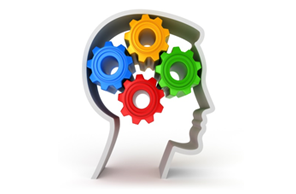
‘The way different areas within those brain networks talk to each other is quite different in children with autism, compared with typically developing children,’ said senior researcher Vinod Menon, a professor of psychiatry and behavioral sciences at Stanford University School of Medicine in California.
One network, called the salience network, showed the most hyperconnectivity — which basically means a greater-than-normal number of brain areas are activated at the same time. The salience network helps the brain decide which part of our environment deserves our attention at any given moment.
Menon’s team found that the more hyperconnectivity kids with autism had in the salience network, the more severe their ‘restrictive’ and repetitive behaviors.”
Source: (1) Health Day, U.S. News and World Report (2013, June 26), ‘Hyperconnectivity’ Seen In Brains of Children with Autism
5. Studies Link ADHD to Obesity and Longer-Lasting Head Injury
Two new studies link ADHD symptoms in childhood to obesity later in life and longer-lasting effects after a head injury. Find more about these studies below!
ADHD and Obesity
A 33 year study from the medical journal Pediatrics published on May 20, 2013 shows men diagnosed with ADHD in childhood had significantly higher rates of obesity than those without an ADHD diagnosis. Pacific Standard Magazine shared the following about the study:
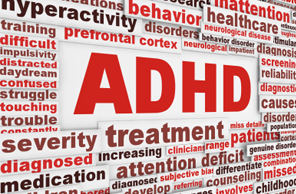
“Researchers surveyed two groups of 41-year-old men and found those with a history of ADHD were 19 pounds heavier than their non-ADHD counterparts, on average…
Data for the new study came from 207 white boys with ADHD who were referred to a research clinic at around age eight and followed as they grew up. Ten years later another group of teenage boys without ADHD, who were otherwise similar to the original participants, were added to the study. By the time they were asked to report their weight at age 41, 111 men from each group were still in the study.
On that survey, men with a history of ADHD reported weighing 213 pounds, on average, and 41 percent of them were obese. In comparison, men without ADHD weighed in at an average of 194 pounds, and 22 percent qualified as obese, Dr. F. Xavier Castellanos from the Child Study Center at NYU Langone Medical Center in New York and his colleagues wrote in Pediatrics.
‘As we learn more about the regions of the brain that may be implicated in obesity, they overlap with brain regions implicated in ADHD,’ Castellanos told Reuters Health. ‘The reward system seems to be relevant to both conditions.’ In addition, he added, ‘There is the speculation that the obesity is at least partly reflecting some of the impulsivity, poor planning, and the difficulty in making choices’ that come with ADHD.”
For more information on this fascinating study, read the rest of the article from Pacific Standard Magazine here!
ADHD and Head Injury
A study from the June 25, 2013 edition of the Journal of Neurosurgery: Pediatrics shows children with ADHD, who are often characterized as impulsive risk takers, are more likely to sustain a moderate disability after a mild traumatic brain injury. Researchers are recommending that children diagnosed with ADHD avoid contact sports in which risk of injury is higher. An article about the study from Health Day states:
“In the new study, Greene and her colleagues reviewed medical charts of all patients at Children’s Hospital of Pittsburgh who had ADHD and were diagnosed with a mild traumatic brain injury between 2003 and 2010. Forty-eight of these children were compared with a control group of 45 children without ADHD who had also sustained a mild traumatic brain injury.
The researchers found that 25 percent of the ADHD group suffered a moderate disability, and 56 percent had completely recovered after a nearly six-month follow-up period. In contrast, among the patients without ADHD, only 2 percent suffered a moderate disability and 84 percent had completely recovered after a much shorter follow-up of seven weeks. Moderate disability was defined as needing supervision or help for physical or behavioral problems, or having residual problems with learning or functioning.”
6. Elevated Antibodies to Gluten Found in Kids with Autism
A study from researchers at Columbia University Medical Center shows elevated levels of gluten antibodies in kids with autism. An article from Newswise about the study shares the following (1):
Researchers have found elevated antibodies to gluten proteins of wheat in children with autism in comparison to those without autism. The results also indicated an association between the elevated antibodies and the presence of gastrointestinal symptoms in the affected children.

They did not find any connection, however, between the elevated antibodies and celiac disease, an autoimmune disorder known to be triggered by gluten…
“This is the first study to systematically look at serologic and genetic markers of celiac disease and gluten sensitivity in such well-characterized cohorts of autism patients and controls,” said Peter H. R. Green, MD, director of the Celiac Disease Center at Columbia University Medical Center and one of the study authors. “But the findings need to be confirmed in larger cohorts…”
Armin Alaedini, PhD who headed the study indicated that larger studies could lead to a better understanding of this immune response to gluten helping to uncover new clues about autism and possibly helping identify biomarkers for a subset of patients who may respond to specific treatment strategies.
Source: (1) Newswise — NEW YORK, NY (June 20, 2013) Elevated Gluten Antibodies Found in Children with Autism
7. Study: Gut Bacteria Affects Brain Function
Gut Bacteria Affects Brain FunctionA recent study from researchers at UCLA links gut bacteria to brain function, underscoring Brain Balance’s assertion that diet has a direct and significant impact on behavior. The small study found that women who regularly consumed probiotics found in yogurt showed altered brain function while in a state of rest and in response to emotion recognition tasks. Read an excerpt below from the UCLA Health online magazine (1), or click here to read the original article in its entirety.
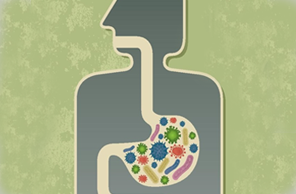
“…The small study involved 36 women between the ages of 18 and 55. Researchers divided the women into three groups: one group ate a specific yogurt containing a mix of several probiotics — bacteria thought to have a positive effect on the intestines — twice a day for four weeks; another group consumed a dairy product that looked and tasted like the yogurt but contained no probiotics; and a third group ate no product at all….
During the resting brain scan, the women consuming probiotics showed greater connectivity between a key brainstem region known as the periaqueductal grey and cognition-associated areas of the prefrontal cortex. The women who ate no product at all, on the other hand, showed greater connectivity of the periaqueductal grey to emotion- and sensation-related regions, while the group consuming the non-probiotic dairy product showed results in between.
The researchers were surprised to find that the brain effects could be seen in many areas, including those involved in sensory processing and not merely those associated with emotion, Tillisch said.
The UCLA researchers are seeking to pinpoint particular chemicals produced by gut bacteria that may be triggering the signals to the brain. They also plan to study whether people with gastrointestinal symptoms such as bloating, abdominal pain and altered bowel movements have improvements in their digestive symptoms which correlate with changes in brain response.
Meanwhile, Mayer notes that other researchers are studying the potential benefits of certain probiotics in yogurts on mood symptoms such as anxiety. He said that other nutritional strategies may also be found to be beneficial…”
Source: (1) UCLA, Health Sciences (2013, May 29). Changing gut bacteria through diet affects brain function.
8. Study: Environmental Enrichment Reduces Autism Symptoms
Results from an autism study in the May 2013 issue of Behavioral Neuroscience show environmental enrichment strategies reduce autism symptoms in boys ages 3 to 12. After six months of an environmental enrichment program that included olfactory and tactile stimulation, the enriched group showed clinically significant improvement of symptoms at a rate of 42% compared with 7% of the control group. Additionally, 69% of parents of kids in the enriched group reported improvement, compared with only 31% of the control group. Researchers are now conducting a larger study that includes girls with autism. Click here to read more about this important and promising study.

9. Multiple Brain Areas Work Together To Make Reading Possible
A recent study that included a combination of brain scans and reading tests showed multiple brain areas must work together to make reading possible. Since October 2013 is National Dyslexia Awareness Month, we invite you to share this fascinating research. A recent article about the study from Domain-b.com shared the following:

“…The small study involved 36 women between the ages of 18 and 55. Researchers divided the women into three groups: one group ate a specific yogurt containing a mix of several probiotics — bacteria thought to have a positive effect on the intestines — twice a day for four weeks; another group consumed a dairy product that looked and tasted like the yogurt but contained no probiotics; and a third group ate no product at all….
“The findings open up the possibility that individuals who have difficulty reading may only need additional training for specific parts of the brain – targeted therapies that could more directly address their individual weaknesses.
‘Reading is a complex task. No single part of the brain can do all the work,’ says Qinghua He, postdoctoral research associate at the University of Southern California (USC) Brain and Creativity Institute.
The study looked at the correlation between reading ability and brain structure revealed by high-resolution magnetic resonance imaging (MRI) scans of more than 200 participants…
‘Our results strongly suggest that reading consists of unique capacities and is supported by distinct neural systems that are relatively independent of general cognitive abilities,’ says Gui Xue, corresponding author of the study. Xue was formerly a research assistant professor at USC and now is a professor and director of the Center for Brain and Learning Sciences at Beijing Normal University.
‘Although there is no doubt that reading has to build up existing neural systems due to the short history of written language in human evolution, years of reading experiences might have finely tuned the system to accommodate the specific requirement of a given written system,’ Xue adds.”
